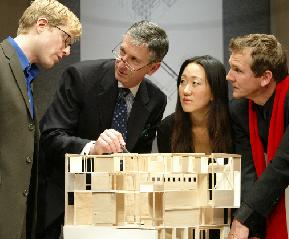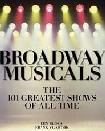SITE GUIDE
SEARCH
REVIEWS
FEATURES
NEWS
Etcetera and
Short Term Listings
LISTINGS
Broadway
Off-Broadway
NYC Restaurants
BOOKS and CDs
OTHER PLACES
Berkshires
London
California
DC
Philadelphia
Elsewhere
QUOTES
On TKTS
PLAYWRIGHTS' ALBUMS
LETTERS TO EDITOR
FILM
LINKS
MISCELLANEOUS
Free Updates
Masthead
Writing for Us
A CurtainUp Review
Private Jokes, Public Places
By Elyse Sommer
|
What they {people} do care about is what sort of environment they live in. They might not always be able to recognize what it is about a space that makes them feel comfortable or irritated. . .But I do know that the people who will come to use my swimming pool will come back to use it again. And I do know it will make them feel a little better about life. . .--- Margaret
|

Anthony Rapp, Geoffrey Wade, M.J. Kang, Sebastian Roché
(Photo:Carol Rosegg)
|
And so this comic examination of the meaning and purpose of modern architecture has the advantage of a timely and intriguing subject enhanced by the cache of an almost-architect author and son of a famous architect (Playwright Oren Safdie was diverted from following in dad Moshe Safdie's footsteps by a playwriting course he took during his last year at Columbia University's School of Architecture school).
Private Jokes, Public Places gained enough altitude from some critical bouqets tossed its way during brief runs in Los Angeles and at LaMama ETC for this third outing at a venue that couldn't be more aptly site-specific: the 150-seat theater at the spanking new Center for Architecture in Greenwich Village that is now home to the New York Chapter of the American Institute of Architects .
The comedy which is as black as the outfits of its cast is the playwright's way of having the best of all possible worlds. Though not using his architectural studies to design wondrous public buildings or to-die-for private homes, Safdie has built on his inside knowledge of the profession to examine the concepts and conceits of our modern "master builders." While Private Jokes, Public Places is all about architecture and its practitioners, it should hit home with anyone who's been caught up in the manipulative gamesmanship and pretentious insider gobbledygook of academia generally — and situations in which women can still be the butt of "private jokes."
The drama centers around the process whereby graduate students at a school for architects must present (and defend) their thesis projects to a jury, and in the presence of an audience of fellow students (with the audience as stand-ins for those students). The focus is on a single student, Margaret, a Korean-American, (M.J. Kang) whose project is an indoor swimming pool. Her jury consists of her studio teacher who's well-meaning but insecure and an architectural nonentity (Anthony Rapp) and two prominent visiting architects (Sebastian Roché and Geoffrey Wade) who are enamored of themselves but not of each other. Instead of trying to understand the young woman's work, they question it with an eye peeled for any chance to jump in with a pompous lecture. Their insensitivity turns Margaret's presentation into an ordeal that leads to a climactic confrontation with an in your face finish which I'm not going to reveal.
The sparring and posturing visitors get the best lines. Roché's wittily portrayed Erhardt spouts a mish-mash of European postmodernist-Freudian gobbledygook with an accent that seems more like a little bit of everything than rooted in Germany as his name implies. His carefully burnished almost clownish Euro-charm is contrasted by Wade's equally sharp rendering of the more sober Colin, an elitist with a cruelly sharp tongue . With his degree in structural engineering, Colin is a realist to whom Erhardt represents all those who have robbed architecture of real meaning.
The obnoxious judges' show-off detours from evaluating Margaret's project leave the nervous student like a beginning swimmer caught in the deep end of her swimming pool. The drama takes a climactic turn when her teacher retrieves the design she threw out in favor of the one she is presenting in a bumbling attempt to help her without antagonizing the other men. Margaret not only refuses to be helped, but stiffens her spine sufficiently to declare herself a budding colleague to whom serious attention should be paid. This turns the intellectual wrestling match between Erhardt and Colin into an alliance based on their shared need to negate her demand.
Safdie cleverly allows some valid points about the need for established principles to penetrate the pretentious dialogue of Erhardt and Colin, just as Margaret's final act of defiance (my lips remain sealed!) may reveal an extremism that advocates using a bomb rather than a broom to effect academic reforms. The four actors are so good that they come close to overcoming the fact that the characters Safdie has given them to portray are representative types rather than real flesh-and-blood people. Despite Sebastian Roché good acting this tendency towards caricature is most evident in his Erhardt.
While the deconstruction of cultural elitism will remind viewers of Tom Wolfe's book From Bauhaus to Our House, I was more reminded of Terrence McNally's Master Class. Like Private Jokes, Public Places, that play was built on the premise of a seasoned professional evaluating the work of students before an audience. The judge in this case was always a fascinating and very real character (Maria Callas), never a mouthpiece. The presenters (there was only one judge and three students rather than three judges and one student) while in many ways typical of ambitious students were also, first and foremost, individuals.
The above quibble notwithstanding, this is an entertaining think piece. Director Maria Mileaf seems to have stepped up the pace so that the previously announced 90-minute running time is shorter by almost fifteen minutes. Neil Patel has wisely kept the tiny stage uncluttered, letting the atmospheric space contribute its own mantle of authenticity. Laurie Churba's variations on black-on-black make their own statements on the characters and the power play at work -- from the red scarf raffishly draped around Erhardt's neck to Margaret's wrap style dress and stiletto heeled boots. Unlike Margaret who presented her project with a bit of still wet glue visible, the actors and creative team have put together a polished presentation of Mr. Safdie's play.
|
PRIVATE JOKES, PUBLIC PLACES
Written by Oren Safdie Directed by Maria Mileaf Cast (In Order of Appearance): Sebastian Roché, Geoffrey Wade, Anthony Rapp, M.J. Kang Set Design: Neil Patel Costume Design: Laurie Churba Lighting Design: Jeff Croiter Music: Alexander Janko Running time: 75 minutes without intermission Theater at the Center for Architecture, 536 LaGuardia Place (Bleecker/ W. 3rd St.) 212/239-6200 From 9/24/03; to 12/21/03; opening 11/05/03. Mon, Tues, Thurs, Fri & Sat @ 8:30PM, Sat @ 5:00PM, Sun @ 3:00PM & 7:00PM-- $50.00. Reviewed by Elyse Sommer |

Easy-on-the budget super gift for yourself and your musical loving friends. Tons of gorgeous pictures.

Leonard Maltin's 2007 Movie Guide

At This Theater
Leonard Maltin's 2005 Movie Guide

 >
>

